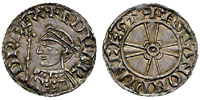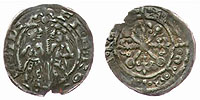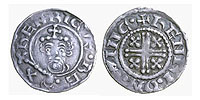This web site has been created by Marshall Faintich, Ph.D.
All photos, drawings, and text are © Marshall Faintich
All of my coins have been sold or have been sent away to be auctioned
Please e-mail any comments you might have
Coins of Celtic and Anglo-Saxon England (100 BC - 1066 AD)
 Coins are shown from the Celtic period up through Harold II in 1066.
Coins are shown from the Celtic period up through Harold II in 1066.
Go to coin images (Thumbnail links - Quick Download)
Coins of Norman England 1066-1153
 Coins are shown from the time of William the Conqueror in 1066.
Coins are shown from the time of William the Conqueror in 1066.
Go to Discussion (Long Download)
Go to coin images only (Thumbnail links - Quick Download)
Coins of the English Anarchy 1138-1153
 Upon the death of Henry I of England in 1135, his nephew, Stephen of Blois, entered England and secured the throne for himself. In 1138, Civil War and anarchy broke out in England, when Matilda, with support from half-brother, Robert of Gloucester, claimed her right to the throne. During this tumultuous period in English history, many irregular and baronial coins were struck in addition to the regular coins of Stephen, and a few of them are shown here.
Upon the death of Henry I of England in 1135, his nephew, Stephen of Blois, entered England and secured the throne for himself. In 1138, Civil War and anarchy broke out in England, when Matilda, with support from half-brother, Robert of Gloucester, claimed her right to the throne. During this tumultuous period in English history, many irregular and baronial coins were struck in addition to the regular coins of Stephen, and a few of them are shown here.
Go to Discussion (Long Download)
Go to coin images only (Thumbnail links - Quick Download)
Short Cross Coinage of England, Scotland, and Ireland (1158-1247)
 Henry II ruled from 1154-1189. His early short cross coinage, first issued in 1158, is commonly known as the Tealby type because of the 1807 discovery of more than 5000 of these crudely struck pennies in Tealby, Lincolnshire, and this type was struck with minor design variations until 1180, when a new and much better struck coinage was issued. The new short cross coinage was struck through the end of his reign, and continued under Richard, John, and Henry III until 1247. All of the English short cross coins bear the name of Henricus Rex, and ordering of the coinage through the four kings is accomplished by die linkage.
Henry II ruled from 1154-1189. His early short cross coinage, first issued in 1158, is commonly known as the Tealby type because of the 1807 discovery of more than 5000 of these crudely struck pennies in Tealby, Lincolnshire, and this type was struck with minor design variations until 1180, when a new and much better struck coinage was issued. The new short cross coinage was struck through the end of his reign, and continued under Richard, John, and Henry III until 1247. All of the English short cross coins bear the name of Henricus Rex, and ordering of the coinage through the four kings is accomplished by die linkage.
Contemporary coinage of Scotland and Ireland is also shown.
Go to coin images only (Thumbnail links - Quick Download)
Long Cross Coinage of England and Ireland
 In 1247, the short cross coinage was replaced with a voided long cross on the reverse design to help safeguard against clipping. In 1279, a new and better struck coinage was issued, with the voided long cross replaced by a solid long cross, and the practice of including the moneyer's name was abandoned.
In 1247, the short cross coinage was replaced with a voided long cross on the reverse design to help safeguard against clipping. In 1279, a new and better struck coinage was issued, with the voided long cross replaced by a solid long cross, and the practice of including the moneyer's name was abandoned.
Go to coin images only (Thumbnail links - Quick Download)
About the Author
E-mail the Author: mfaintich@cyberwind.net





